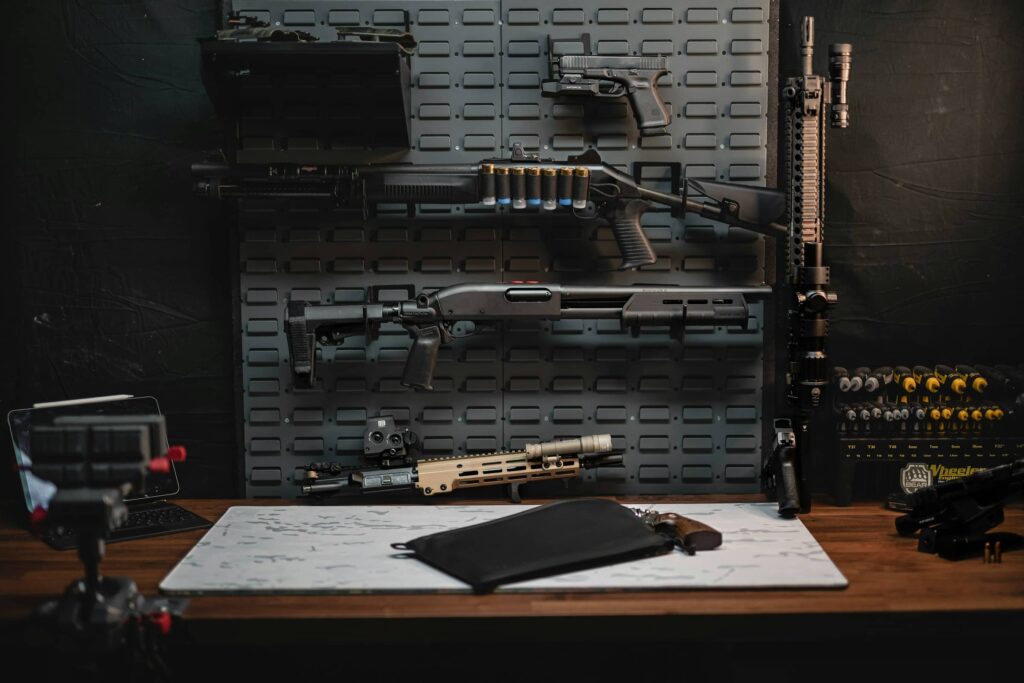Did the Gun Control Act of 1968 shape the trajectory of U.S. firearms legislation, or merely patch existing loopholes? Signed into law by President Lyndon B. Johnson, this landmark Act introduced unprecedented restrictions on the firearms industry. It prohibited mail-order sales of rifles and expanded the list of individuals barred from purchasing firearms.
This post will go over the historical significance of the Act, outlining its major provisions and lasting impacts on American gun laws. You will gain insight into how this piece of legislation transformed the landscape of gun regulation.
Table of Contents
Understanding the Gun Control Act of 1968
The Gun Control Act of 1968, signed by President Lyndon B. Johnson on October 22, marked a huge moment in U.S. firearms regulation. This legislation introduced significant changes aimed at regulating the firearms industry and reducing gun violence. The Act was a response to increasing concerns about gun-related crimes and high-profile assassinations in the 1960s, including that of President John F. Kennedy.
What were the major changes introduced by the Gun Control Act of 1968? The Act implemented stricter licensing requirements for the firearms industry, making it mandatory for dealers to obtain federal licenses. It also banned the interstate sale of firearms by mail, which was seen as a critical measure to prevent easy access to guns. Furthermore, the Act expanded the categories of individuals prohibited from purchasing firearms, including convicted felons, drug users, and individuals deemed mentally incompetent.
Key provisions and restrictions introduced by the Act include:
- Stricter licensing requirements for firearms dealers.
- Prohibition of mail-order sales of rifles and shotguns.
- Expansion of prohibited categories to include felons, drug users, and those with mental incompetence.
- Mandate for serial numbers on all firearms to aid in tracking and prevent illegal trafficking.
- Restriction on the importation of guns not deemed suitable for sporting purposes.
The long-term impact of the Gun Control Act of 1968 has been substantial in shaping the landscape of American gun laws. It laid the foundation for future legislation and ongoing debates surrounding gun control. While it was a step towards regulating firearms more effectively, critics argue that it did not go far enough in addressing the root causes of gun violence.
Nevertheless, the Act remains a critical piece of legislation in the history of U.S. firearms law, influencing both policy and public dialogue on gun regulation for decades.
Key Amendments to the Gun Control Act
What were the significant amendments to the Gun Control Act of 1968? The Firearms Owners’ Protection Act of 1986 and the Brady Handgun Violence Prevention Act of 1993 stand out as crucial legislative changes.
The 1986 Act eased restrictions on firearms sellers, allowing for more flexibility in gun transactions and limiting the Bureau of Alcohol, Tobacco, and Firearms (ATF) inspections, which some saw as a necessary correction to overreach. Meanwhile, the Brady Act in 1993 introduced mandatory background checks for handgun purchasers, aiming to prevent firearms from falling into the wrong hands.
Here is a comparison of the original Gun Control Act provisions and the changes brought by these amendments:
| Provision | Gun Control Act of 1968 | Firearms Owners’ Protection Act 1986 | Brady Handgun Violence Prevention Act 1993 |
|---|---|---|---|
| Licensing and Inspections | Strict licensing for dealers | Eased restrictions and limited inspections | N/A |
| Background Checks | Not initially required | N/A | Introduced mandatory checks for handgun buyers |
| Gun Shows | Restricted | Allowed sales at gun shows | N/A |
The Firearms Owners’ Protection Act made it easier for law-abiding citizens to purchase firearms while addressing concerns about federal overreach. On the other hand, the Brady Act added a layer of vetting through background checks, which aimed to enhance public safety by reducing the risk of firearms reaching ineligible individuals.
Both amendments reflect the ongoing balancing act of protecting gun rights while ensuring responsible ownership.
The Role of Federal Regulations in Gun Control
What is the Federal Firearms License (FFL) system? The Federal Firearms License system, introduced by the Gun Control Act of 1968, requires individuals and companies selling firearms to be licensed. This licensing system is important for regulating gun sellers and ensuring that firearm transactions adhere to federal standards. By mandating FFLs, the Act aims to create accountability among dealers and prevent illegal gun sales.
Federal regulations establish a framework that impacts gun ownership, sales, and safety, providing a baseline of requirements across all states. These regulations ensure that firearms are sold legally and help maintain a record of transactions, which is important for tracing weapons involved in crimes.
What challenges do these regulations face? Despite their intentions, federal regulations often encounter challenges in enforcement. One major issue is the inconsistent application of regulations across states, leading to a patchwork of enforcement that can undermine the effectiveness of the Gun Control Act. Additionally, the limited resources for inspections and enforcement can hinder the ability to oversee FFL holders adequately. These challenges highlight the ongoing struggle to balance regulatory oversight with the rights of gun sellers and owners.
Controversies and Public Opinion on the Gun Control Act
What were the mixed reviews of the Gun Control Act? The Act received a variety of responses, with some commentators labeling it a “better than nothing” effort. Critics argued that it fell short of making impactful changes in gun control. This perception stemmed from the belief that while the Act introduced new regulations, it did not adequately address the root causes of gun violence.
Major criticisms from various groups included:
- Limited Crime Reduction: Critics argued that the Act would not effectively reduce crime, suggesting that criminals could still find ways to obtain firearms.
- Infringement on Rights: Some groups saw the Act as an infringement on Second Amendment rights, limiting lawful gun ownership.
- Insufficient Enforcement: There were concerns about the Act’s ability to be enforced effectively, given the lack of resources and oversight.
The Gun Control Act continues to spark debate on its role in reducing gun violence. Public opinion remains divided, with supporters emphasizing the need for regulation to ensure public safety. In contrast, opponents argue that the Act imposes unnecessary restrictions on law-abiding citizens. This ongoing discourse reflects broader tensions in American society between the desire for safety and the protection of individual rights. The Act’s legacy is a testament to the complex nature of balancing these priorities in the realm of gun legislation.
The Impact of the Gun Control Act on Gun Rights
The Gun Control Act of 1968 was the first major firearms law after WWII which help set the stage for future debates and shaping subsequent laws. It established baseline regulations that have since been expanded and amended through acts like the Brady Handgun Violence Prevention Act. By mandating stricter controls on who could purchase firearms and how they could be sold, the Act created a framework that prompted continual legislative adjustments aimed at balancing gun rights with public safety concerns.
Key effects of the Gun Control Act on gun rights and ownership include:
Expansion of Prohibited Purchasers: Broadened the categories of individuals barred from buying firearms, impacting certain citizens’ ability to exercise their gun rights.
Strengthened Licensing Requirements: Increased the regulatory burden on firearms dealers, affecting how guns are distributed and sold.
Interstate Commerce Restrictions: Limited the ability to purchase firearms across state lines without going through licensed dealers, influencing gun ownership logistics.
The ongoing relevance of the Gun Control Act in today’s gun control debate remains significant. It continues to be referenced in legal and political discussions as a foundational piece of legislation that has shaped the trajectory of gun regulation in the U.S. Despite criticisms, its influence continues.
Final Words
The Gun Control Act of 1968 marked a turning point in U.S. firearms legislation. Its introduction of stricter licensing and sales regulations shaped gun control efforts significantly. The Act’s amendments, including the Firearm Owners’ Protection Act and the Brady Handgun Violence Prevention Act, further influenced the legal landscape.
Federal regulations enforce these laws, yet challenges remain. Public opinion on the Act remains mixed, reflecting ongoing debates about gun rights and control. The Gun Control Act continues to inform discussions on firearms regulation, highlighting its enduring impact on American society.
FAQ
What did the Gun Control Act of 1968 do?
The Gun Control Act of 1968 introduced stricter licensing and regulation for the firearms industry. It prohibited mail-order sales of rifles and shotguns and expanded prohibited buyers to include felons and the mentally incompetent.
Why was the Gun Control Act of 1968 passed?
The Act was passed to address rising concerns over gun violence, spurred by the assassinations of prominent figures in the 1960s, aiming to enhance public safety through better regulation of firearm sales and ownership.
Is the Gun Control Act of 1968 still in effect?
Yes, the Gun Control Act of 1968 is still in effect. It continues to serve as a foundation for federal firearm regulations, though it has been amended by subsequent legislation.
What is the Firearms Owners’ Protection Act?
The Firearms Owners’ Protection Act was an amendment to the Gun Control Act of 1968. It eased restrictions on sellers, limited ATF inspections, and addressed interstate firearm sales.
How have federal gun laws evolved since the Gun Control Act of 1968?
Federal gun laws have evolved by adding amendments such as the Brady Handgun Violence Prevention Act for background checks and the Bipartisan Safer Communities Act requiring more checks for young buyers.
- The Right Gear for Upland Hunting - December 21, 2024
- How to Get a Suppressor in a Few Steps - December 5, 2024
- What is The Protection of Lawful Commerce in Arms Act? - November 15, 2024




